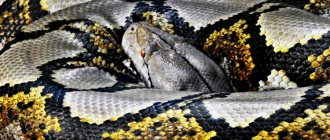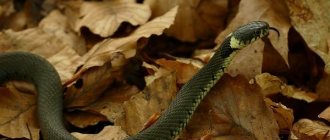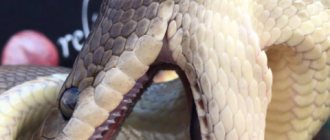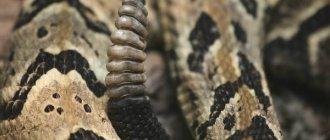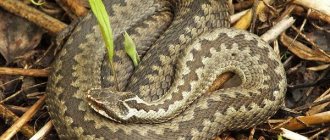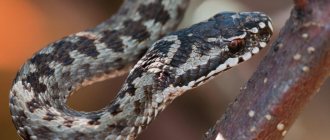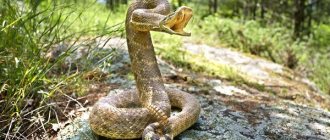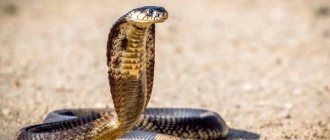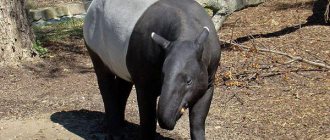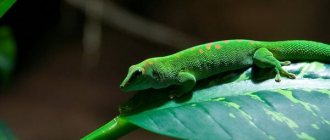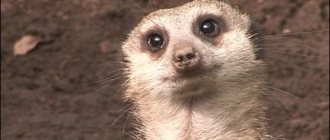- Wild animals
- >>
- Reptiles
According to legends and foreign cinema, the anaconda is an incredibly huge and dangerous snake. Surprisingly, it is not uncommon to hear from people about the size of an anaconda that is two to three times its true size. These, of course, are all fairy tales and fictions, once presented as official data. Everything is much more modest, the anaconda is indeed the largest snake, but only statistically. She is also quite calm and is not interested in such large prey as humans.
Does the anaconda really exist?
Myths and legends regarding one of the largest snakes on earth have reached us since ancient times. Books were written about anacondas and films were made in which the reptile was presented as a huge bloodthirsty monster. Some may even get the impression that the anaconda is some kind of mythical creature invented by man. It's hard to imagine that there actually is a snake that can completely swallow an adult man.
Photo of anaconda snake
Anacondas actually exist, however, their size and danger are greatly exaggerated in many sources. A large female adult anaconda is indeed capable of swallowing a person whole, but he is not a sufficiently attractive food item for these snakes.
Anacondas prefer smaller prey. And they themselves do not always reach such enormous sizes.
Giants of the animal world: descendants of ancient snakes
Ancient books mention powerful and great snakes that are capable of swallowing a person and even digesting a healthy bull. Evolutionary biologists are still debating the origins of reptiles.
Anaconda
Some believe that the snake originated from reptiles, while others refute this fact, expressing an opinion about the relationship between the snake known today and the ancient aquatic descendant. The huge ancient fossils on display in museums are comparable to the size of a school bus. The findings and assumptions of many biologists and scientists still remain the subject of debate and hypotheses that still await scientific confirmation or refutation.
Description
The anaconda genus belongs to the subfamily Boa constrictors, a family of pseudopod snakes. Most often, when people call “anaconda” they mean the largest and most famous representatives of this genus – green anacondas. There are other names for this species: water boa, common anaconda, giant anaconda.
Anaconda photo and description
The anaconda was first described in 1553 in the book “Chronicle of Peru” by Pedro Cies. This is a very massive snake, which is considered the heaviest in the world. Females are often approximately twice the size of males. While hunting, the snake can reach speeds of up to 40 km/h.
In water, the anaconda moves at speeds of up to 25 km/h. She develops such speed thanks to her well-developed muscles, which also helps her to choke the victim. This is a very strong reptile. The compression force is 16 kg per 1 square centimeter.
In the wild, anacondas live for about 11 years. Unfortunately, it is not easy to create suitable conditions for these reptiles in captivity, so the average lifespan is 5–6 years. However, there are cases where in captivity an anaconda lived up to 28 years.
It belongs to the class of reptiles, the order Scaly, the suborder of snakes, the infraorder of lower snakes, the family of pseudopods, the subfamily of boa constrictors, and the genus of anaconda.
2. Anacondas live on the island of Trinidad, as well as throughout the tropics of South America: the range covers countries such as Venezuela and Peru, Brazil and eastern Paraguay, Ecuador, northern Bolivia, Colombia, Guyana and Guiana.
3. According to etymologists, the name of the snake originates from the Sinhalese language and comes from the word “henakandaya”, meaning “rattlesnake”. Another version says that the anaconda got its name from a Tamil word that sounds similar to the word “anaconda,” which translates as “elephant killer.” In the scientific classification, the genus name sounds like Eunectes, which in Latin means “good swimmer.”
4. Like most large snakes (pythons and boas), anacondas grow throughout their entire life cycle, the first years are especially intensive, and when mature, much slower.
5. The genus of anacondas includes 4 modern species of snakes: giant anaconda, Paraguayan anaconda, Eunectes beniensis anaconda, Deschauensey's anaconda.
Giant anaconda
6. Giant anaconda (common anaconda, green anaconda) is the largest species of anaconda with a body length of about 5-6 meters, and a weight of 97 kilograms or more. Scientists have found that the giant anaconda, 9 to 11 meters long, is a myth, since its length does not exceed 6.5 meters.
7. The body of this snake is gray-green, the back is covered with 2 rows of large brown spots of a round or oval shape, arranged in a checkerboard pattern.
8. Along the side surface of the snake’s body there is a series of small yellow round markings with a black border.
9. The giant anaconda lives in the tropical zone of South America from Brazil and Paraguay to Bolivia, Peru and the island of Trinidad.
10. The snake prefers low-flow, muddy creeks and shallow lakes of the Amazon and Orinoco river basins.
Paraguayan anaconda
11. The Paraguayan anaconda, also known as the southern or yellow anaconda, has a length of 2 to 4 meters.
12. Most representatives of this species are yellow in color, but there are greenish and gray individuals.
13.The body of this anaconda is decorated with a large pattern of black or brown spots of a round or oblong shape with a light center.
14.The Paraguayan anaconda lives in stagnant or slow-flowing waters of Paraguay, northern Argentina and southern Bolivia. Despite its gigantic size, the anaconda often becomes a victim of a jaguar or caiman, and a wounded snake can attract the attention of a school of piranhas, which can also attack the weakened animal.
15. These huge snakes are excellent swimmers, because they spend almost their entire lives in the water, occasionally crawling ashore to bask in the sun, or climb trees, wrapping their body rings around the lower branches. If the reservoir dries up, the anaconda snake moves lower along the river bed or buries itself in the silt and goes into suspended animation until the rainy season.
16. Anaconda Eunectes beniensis is a snake that resembles the Paraguayan anaconda in appearance, and therefore there is a possibility that this species can be classified as Eunectes notaeus.
17. The length of the anaconda is 4 meters, these snakes have a brownish-olive or brown color on the back and a gray-brown-yellow color on the lower part of the body. The pattern is represented by 5 longitudinal dark stripes on the head and hundreds of uniformly dark spots on the back.
18.This species of anaconda inhabits swamps and rainforests in northeastern Bolivia and possibly adjacent areas of Brazil.
19. The anaconda is not a poisonous snake, and it is characterized by a hunting method characteristic of all boa constrictors: the snake motionlessly guards its prey, and then makes a sharp throw, wraps its muscular body around the victim and strangles it. But it does not crush or break the animal’s bones, as boa constrictors usually do. As a result, the anaconda's victim dies from suffocation. The snake can also grab prey with its teeth.
20. Despite the powerful stomach acids, large food is digested for several weeks, leaving a significant supply of nutrients and energy in the reptile’s body. Thanks to this feature, anaconda snakes are by no means voracious and can go completely without food for a long time.
Anaconda Deschauensei
21. Deschauensei's anaconda is a rare, little-studied species, the representatives of which are distinguished by their relatively small size: the length of an adult anaconda is 1.3-1.9 meters. The snake lives in swampy areas in northeastern Brazil and Guiana.
22. The snake’s body is divided into a tail and a huge body with 435 vertebrae. Its ribs are mobile and allow it to swallow very large prey.
23.The anaconda skull consists of movable bones connected by ligaments. It is thanks to this feature that it opens its mouth wide and swallows its prey whole.
24. Highly located eyes and nostrils allow the anaconda to breathe underwater. Its eyes allow it to quickly track prey rather than focus, thanks to transparent scales.
25.An important organ of a snake is the tongue, which is responsible for taste and smell. The anaconda feeds on various species of mammals and reptiles; fish occupies the least significant part of the snake’s menu. Its food includes agoutis, iguanas and other lizards, waterfowl, as well as some large animals: capybaras, peccaries, young caimans, turtles, capybaras, tupinambis and snakes, including fairly large pythons.
26. The teeth of a giant anaconda do not contain poison, although they are sharp and long, so the bite is not fatal to humans.
27. The skin of an anaconda is dry and dense because it does not have mucous glands. But it is shiny, thanks to its scales.
28. The molting of these reptiles occurs according to the principle of “a stocking turned inside out” - the snake sheds a single layer at a time.
29. In accordance with scientifically confirmed data, the largest female anaconda was caught in Venezuela: the length of the anaconda was 5 meters 21 centimeters including the tail, and the body weight was 97.5 kilograms.
30. The first official mention of the anaconda in a work of fiction is found in the story “Chronicles of Peru” by Pedro Cieza de Leon, which was written in 1553. The author claims that this information is reliable and describes the anaconda as a huge snake 20 feet long with a reddish head and evil green eyes. She was subsequently killed and a whole fawn was found in her stomach.
31. Compared to the boa constrictors we are used to, anacondas are much stronger and more aggressive. They can bite or attack a person, but more often they still prefer not to get involved in a conflict. Left alone with a giant reptile, you need to be very careful and do not provoke the anaconda with loud sounds or sudden movements.
32. The strength and musculature of this snake far exceeds the strength of a boa constrictor; it is generally accepted that one coil of the anaconda’s body is several times stronger than one coil of a boa constrictor.
33. Anaconda is the largest snake in the world fauna, and females grow much larger than males. According to the most reliable and verified information, the usual length of this snake does not exceed 4–5 meters.
34. Anaconda does not know how to paralyze its victim with its gaze. They can only put you into a stupor from their wild smell.
35.People were afraid of the anaconda and considered it a bloodthirsty snake; in fact, only one attack was recorded on a teenage boy from an Indian tribe.
36. Anacondas lead a solitary lifestyle, and gather in groups only during the breeding season. The mating season coincides with the rainy season, which in the Amazon basin begins in mid-spring.
37. During the breeding season, anacondas crawl onto land, and males look for females by the smell of pheromones that females leave on the ground.
38.One female can have several partners. Anacondas, like other snakes, mate by curling into a ball consisting of intertwined bodies. To hold a partner, males use rudimentary organs of the hind limbs - a method characteristic of all representatives of the pseudopod family. At the same time, a grinding sound comes from a ball of grappling giant snakes.
39. Anacondas are ovoviviparous snakes; the incubation period is 6-7 months, during which the female becomes severely emaciated, losing almost half her weight.
40. Very rarely, pregnancy ends with the laying of eggs: as a rule, the egg shells burst in the mother’s womb, and from 28 to 42 cubs are born (according to one version, there may be about 100 baby snakes).
Anaconda at the zoo
41. Anaconda lives in many public and private zoos around the world, but it is very difficult to create comfortable conditions for reproduction and therefore snakes rarely live up to 20 years in captivity, and the average life expectancy in zoos is short: 7–10 years.
42. Swedish zoologist G. Dahl in his diaries describes an animal more than 8 meters long that he caught in Colombia, and his compatriot Ralph Bloomberg describes anacondas 8.5 meters long.
43. But such sizes are rather an exception to the rule, and stories about caught 11-meter anacondas are nothing more than hunting tales.
44. Anacondas do not hunt humans, and local Indian tribes often catch anacondas for their tender and tasty meat, and use the skin to make various souvenirs and crafts for tourists.
45. When a person is in the water, the snake does not fully see him and can easily mistake him for a capybara or a baby deer.
Gerald Durrell
46. The famous English zoologist Gerald Durrell describes his hunt for an anaconda and describes it not as a formidable predator, but as an animal that weakly defended itself and did not show aggression. The zoologist caught her by simply grabbing her by the tail and throwing a bag over the head of the “fierce anaconda.”
47. It is not known exactly how long an anaconda lives in natural conditions, but in captivity the average age of a snake is 5-6 years. The maximum recorded lifespan of an anaconda was 28 years.
48. When in danger, the anaconda hides in the nearest body of water and can remain under water for a very long time.
49. Due to the fact that this reptile leads a very secretive and inconspicuous lifestyle, its number until now has only an approximate value. Therefore, it is still a problem for scientists to accurately count the number of anacondas in a certain region.
50. Population dynamics are accordingly also poorly monitored and the Red Book states that there is no threat of extinction of the species. According to a number of scientists, the anaconda is not an animal that is in danger of extermination.
photo from the Internet
Anatomy
The snake has a large muscle mass, with which it strangles its prey. The skeleton is divided into an axial part and a tail. An adult anaconda has 435 vertebrae. Since ancient times, she has preserved the rudiments of all the hip bones. The ribs are elastic and movable. This is necessary so that the snake can swallow very large prey.
The largest snake in the world is the anaconda
Anacondas have very poor hearing and vision, but they have a well-developed nervous system, thanks to which they perfectly sense water vibrations. The bones in the skull are connected by elastic ligaments, allowing the mouth to open very wide.
The eyes are protected by transparent scales, there are no eyelids. The largest officially recorded weight of an anaconda is 97 kg, body length is 5.2 meters. That is why the anaconda is considered the largest snake in the world. In addition, it is one of the snakes with the longest body length.
On average, adult females reach a length of about 4 meters and a weight of 50 kg. Males are rarely longer than 2.7 meters.
Diet
These reptiles are most active during sunrise and sunset, making them crepuscular animals. Anacondas are carnivores, which means that they eat other animals that they manage to catch and swallow. These are loners, spending most of their time in or near water, quietly waiting for prey in ambush.
Photo: Brad Moon
Smaller individuals eat:
- birds;
- fish;
- young caimans (crocodiles);
- frogs;
- small mammals;
- other snakes.
Adult anacondas feed on caimans, tapirs, turtles, capybaras, jacan birds, pudú (a type of deer), agouti (rodent) and many other vertebrates. There is also information about cannibalism among these snakes. Usually, the larger female eats the smaller male... as a snack after a lovey-dovey one-on-one conversation.
Photo: Brad Walker
The anaconda, like any other snake, strangles its victim, wrapping it in the coils of its body. The prey is swallowed whole and digested over several weeks. After a large meal, the anaconda usually fasts for a long period of time - even several months. In captivity, a record time of hunger strike was recorded - 2 years!
Appearance
Anacondas have thin vertical pupils. The eyes and nostrils are located very high on the muzzle, thanks to which the snake can sit in ambush for a long time, almost completely hidden under water. The scales are dry, glossy.
Photo of anaconda mouth
The green anaconda is a shade of brownish-green, olive, or grayish-green and has egg-shaped black spots on its body. They are arranged in a checkerboard pattern. The Paraguayan anaconda has a pattern of saddles, spots and stripes (usually black or dark brown) on a yellow, golden brown or chartreuse background.
Habitat
The snake lives in the rivers and swamps of South America east of the Andes. It is found in Brazil, Colombia, Venezuela, eastern Paraguay, Ecuador, Uruguay, northern Bolivia, Guyana, northern and eastern Piru, French Guiana and the islands of Trinidad. In the CIS countries, the anaconda can only be found in zoos and private collections.
Anaconda in the wild
The climate is tropical: hot and humid, so there is a lot of greenery and foliage in which the snake hides.
Anaconda lives in places that are difficult for humans to reach. But sometimes it can be found near pastures. The snake is not averse to feasting on chickens, ducks, sheep, pigs and even dogs. The anaconda spends most of its time hiding in murky waters.
To digest food, the snake crawls out into the sun's rays onto a rocky shore or onto tree branches. During a drought, it can go downstream or go in search of another body of water.
Often anacondas bury themselves in the mud and hibernate until the pond is filled again.
Tobago Island
It has the same amazing diversity of flora as Trinidad. There are cultivated coconut and sugarcane plantations here. The island is rich in its diverse fauna. It is home to possums and howler monkeys. This is another place where anacondas, hummingbirds and condors live.
Also in Tobago there is an abundance of alligators and various lizards, which have chosen the thickets of mangrove trees growing at the mouths of rivers. This place is also ideal for anaconda life.
Varieties
The anaconda genus includes several species that differ in habitat and appearance:
- The giant (green, common) anaconda lives in rivers and swamps of the tropics. Considered the most massive snake in the world.
- The Paraguayan or yellow anaconda lives in Bolivia, Paraguay, Brazil, Argentina and Uruguay. This is not a very large species, the average length of which reaches three meters.
- The Dechaouensei anaconda is found in Brazil and French Guiana. The length of an adult female can reach two meters.
Natural enemies of the anaconda
Due to their large size, anacondas do not have many natural enemies. Caimans, jaguars and other large snakes and cats pose a danger to them. Sometimes wounded individuals become victims of piranhas. Anacondas are cannibals, as they themselves are not averse to snacking on their fellow creatures. The greatest danger to anacondas is people. In some villages in America, anaconda meat is eaten. Their skin is used to sew clothes and accessories. Illegal fishing of snakes is carried out for the purpose of selling wild animals to private collections.
Leopards caught and killed an anaconda
Local residents kill anacondas out of fear, as many consider these snakes dangerous to humans. But since anacondas live in wild places well hidden from humans, they are not in danger of extinction.
Classification
- Kingdom: Animalia (animals)
- Phylum: Chordata
- Class: Reptilia (reptiles, reptiles)
- Order: Squamata (scaly)
- Suborder: Serpentes (snakes)
- Family: Boidae (pseudopods)
- Subfamily: Boinae (boa constrictors)
- Genus: Eunectes (anacondas)
As can be seen from the classification, the anaconda belongs to the boa constrictor family. Like pythons, they are classified as constrictor snakes, but the difference between these genera is significant - anacondas do not lay eggs, they are viviparous. Their closest relatives are common, tree and rainbow boas.
Anaconda hunting: how it happens
The natives of South America have hunted anacondas since ancient times. Most often they were tracked on land. The hunter carefully approached the snake resting in the sun and hit it on the head with a large stone. If the snake did not die immediately and wriggled for a while, the hunter watched the reptile on the sidelines. When the snake stopped showing signs of life, the hunter took it home.
Photo of green anaconda
Anacondas are also often caught for sale and for the purpose of scientific research. If the snake is large, two people are needed to hunt it: one grabs the reptile by the head, and the other grabs the tail. When a snake is caught, its jaw is secured to prevent it from biting.
Next, the snake is placed in a special bag.
What does an anaconda eat in the wild?
Although the anaconda spends a lot of time in the water, it rarely eats fish. Possible food items depend on the size and age of the snake itself. The babies feed on rats, chicks, small fish and frogs.
The snake caught its prey
Adult anacondas hunt birds, capybaras, wild boars, caimans, iguanas, agoutis, and other snakes.
It is worth noting that anacondas prefer to eat not very large foods. Humans are not attractive food for anacondas. An attack is possible only if the snake confuses a person with other prey.
To protect itself, an anaconda can bite. But most often, snakes try to run away and hide when a person approaches.
Attacks on people
An anaconda is big enough to swallow a human child. Unfortunately, some cases of human encounters with an anaconda have been fatal... As we know, this snake is capable of swallowing a victim up to ¼ of its body length and comparable weight.
However, anacondas live in relatively remote regions, so attacks on humans are not common. But even when meeting a person, anacondas in most cases crawl away, and only if they try to capture them will they try to bite. Considering that the anaconda's teeth are quite short, the marks from its bites heal quickly and without significant consequences.
How does an anaconda kill?
Anaconda is quite lazy. She can spend long hours waiting for a victim who decides to go down to the river to drink. As soon as the victim approaches the snake, it makes a rapid jerk.
She bites into her prey with her fangs. The snake is not poisonous, so it bites the victim only to hold it, then quickly wraps itself around its prey. Unlike a python, it does not break ribs and bones, but rather suffocates. Sometimes the anaconda drags its prey underwater and drowns it. As soon as the victim stops showing signs of life, the snake swallows it whole.
Snake head
The anaconda can be considered a nocturnal reptile, since it is in the dark that it is most active. Since reptiles have a slow digestion process, snakes hunt infrequently. One large catch can last her for several months.
Features of reproduction
Anacondas live alone most of their lives. They come together only during the mating season, which lasts from April to May. Males become sexually mature much earlier. They are able to fertilize a female when they reach a length of two meters. For the female to fully bear offspring, she must reach about four meters in length.
She becomes sexually mature only in the fourth year of life. The female, ready for fertilization, secretes pheromones with special glands. During the mating period, she is not particularly active, but a large number of males accumulate around her.
They constantly stick out their tongues, trying to catch the scent of the female. Snakes are literally intertwined into one ball. From two to twelve males can participate in mating, and they arrive in this state for up to four weeks.
Paraguayan anaconda – photo
Often large and massive females themselves choose which male to mate with. Some males are eaten by her. Males cling to the female using the rudiments of their hind legs.
These are modified limbs that have the shape of small claws located at the anus. Mating often occurs in water. Anacondas are ovoviviparous. In some cases, they are capable of laying eggs.
Pregnancy lasts 6–7 months. During this time, the female may lose half of her original weight, as she does not feed.
On average, 30–50 cubs are born. In some cases, a female is capable of producing 100 individuals. On average, the length of babies is 60 cm. They are attached to the yolk sac by their navels, and are themselves surrounded by a transparent membrane. Anacondas do not care about the born offspring.
Babies are born well developed and fully viable. Almost immediately after birth, they hide in the thickets, and then go in search of food.
What is the difference between an anaconda and a boa constrictor and a python?
Sometimes the anaconda is called a water boa. But the anaconda differs from pythons and boas in its lifestyle and appearance. Unlike other members of the genus, the anaconda is a water snake. It rarely appears on land and can spend long periods of time underwater. Pythons and boas can also swim, but they prefer to spend most of their time on land, where they mainly hunt prey.
Boas are much shorter and thinner than anacondas. Pythons often reach greater lengths than anacondas, but they are not as massive. Even despite the significant gap in length, anacondas weigh much more than pythons.
Is it possible to keep an anaconda at home?
Anacondas live in many zoos and are occasionally found in home collections. Most often you can find giant and Paraguayan anacondas on the market. There are human-bred morphs of these species that are quite expensive. Small anacondas are very aggressive. This is due to the fact that young animals often become victims of other predators. And yet, professionals advise buying young individuals. Firstly, babies don't have such big teeth. If bitten, the person will not suffer serious injury.
Anaconda and man
At the same time, a bite from an adult can leave impressive scars. Secondly, it is easier to accustom a baby to a person. Over time, the snake becomes calmer towards its owner and no longer perceives him as a threat.
Anacondas are territorial animals, so it is better not to keep them together. Each individual should have its own terrarium.
Although the anaconda is a semi-aquatic snake, in some collections it is quite successfully kept in ordinary cages. The pond for the snake is replaced by a large drinking bowl, in which the reptile can soak before molting. If the terrarium has a whole pool, you need to take good care of its cleanliness.
The water temperature should be maintained around 23–24 degrees. The background temperature of the terrarium is 27 degrees, the temperature at the heating point is 33 degrees.
Is it possible to keep at home
Only the Paraguayan subspecies is suitable for home keeping, but only professional terrarium keepers are advised to keep such a dangerous creature at home.
In order for the animal to feel comfortable, it needs to be provided with a very large terrarium, approximately the size of a small room, in which a large pool will be placed, since it is simply vital for the creature to be regularly in the water.
Rats and rabbits are suitable as food. It is recommended to feed small individuals once every 15 days, adults - once a month. In order not to provoke the animal’s aggressiveness towards humans, you should not give it live food.
The terrarium must be cleaned and the water in the pool changed every day; the humidity in the home should be maintained at a very high level - at least 90%. The overall temperature in the terrarium should be at least +25 °C; be sure to provide the anaconda with a warm corner with a temperature of +30 °C.
The reptile is provided with 2 shelters; coconut mulch and peat mixture are suitable as a substrate; snags are also installed so that the snake can crawl on them.
Precautionary measures when keeping an anaconda at home include the following points:
- Do not be alone when dealing with a snake - it is necessary to have someone to save you in the event of an animal attack.
- You should not pick up a pet anaconda - these snakes do not tolerate invasion of personal space, so they often bite or squeeze hands, even causing fractures.
- Close the terrarium tightly so that the snake cannot get out of it on its own.
- It is advisable that the room in which the terrarium is located is tightly closed. For safety reasons, it is not recommended to install it in a bedroom or room where people relax or sleep.
Important! When the terrarium is open, never allow pets or small children close to the snake, as there is a high chance that the anaconda will swallow them in a matter of seconds.
Thus, the anaconda is a very large creature that is a dangerous predator in its habitat. It is not recommended to keep an anaconda at home, but if you decide to get such a unique friend, you need to try very hard and spend money to provide the snake with the necessary conditions for a normal existence.
Legends of the anaconda
In the myths of Latin American peoples, the anaconda is represented as a deity, a werewolf, an evil ogre or a magical spirit that is capable of healing. There are legends that a snake can hypnotize its prey with its gaze and breath.
She makes people fall in love and kidnaps. Thanks to myths, legends, literature and cinema, many people are sure that the anaconda is a giant snake that hunts a person, strangles and kills him. In almost all works of fiction, the danger of the anaconda to humans is greatly exaggerated.
Man holding anaconda snake
There are only isolated cases where a snake actually killed and swallowed people. In ordinary life, anacondas try to stay away from humans because they consider them dangerous. Legends often exaggerate the maximum size of the anaconda. Local residents of Latin America reported to the European explorer that they saw individuals ranging from 10 to 18 meters in length.
Members of an expedition in Colombia reported that they came across a snake 11.4 meters long, but did not provide any evidence of this.
At the beginning of the 20th century, the Wildlife Conservation Society offered a large monetary reward to anyone who found a snake measuring 9 meters or more. Soon the award was canceled as cases of killing and removal of snakes from their natural habitat became more frequent.
Anaconda has received its place in world culture. Willard Price, who is world famous for his fairy tales, mentioned a ten-meter anaconda in his Amazon Adventure. The first film in the Anaconda franchise was released in 1997, which also exaggerated the size and lethality of the snake.
We recommend watching a video about anaconda:
Weaknesses of the Intimidating Reptile
The natural habitat for anacondas is ponds with large thickets. Here the hunt for prey takes place, stocking up on the required amount of fat for bearing offspring. Increased appetite is typical for anacondas during the premarital period. The female absorbs a large amount of food, because during pregnancy (7 months) she will not eat food. Bearing offspring for some snakes ends tragically: death from starvation at the end of the term is a common occurrence.
The process of eating food is also considered a dangerous moment for the life of a reptile. After all, at this moment the snake is defenseless against a potential enemy, and if another predator sees it while swallowing food, most likely the snake itself will become a victim. If we take into account such a distinctive feature as the duration of ingestion of more than 5 hours, then there is plenty of time for the snake to be absorbed by a predator. The reptile becomes a victim of an attack by a jaguar, caiman or a school of piranhas in a pond.
Interesting Facts
Since the anaconda lives in hard-to-reach places, it is difficult to reliably say how many people have become victims of the snake. Only one case of death was recorded, a 13-year-old Indian boy. Nevertheless, after scientific research, the snake was found to be deadly to humans. Anacondas don't breathe underwater. It has special valves on its nose that close when the reptile dives.
Without emerging, a snake can spend up to two hours under water. Anacondas swallow their prey whole, starting from the head. At the same time, the snake’s muscles actively contract, pushing the victim inside the body. At such a moment, the anaconda is most vulnerable, since its only means of defense - its head - is occupied with prey. The duration of absorption depends on the size of the prey and can take up to several hours.
In 2014, English naturalist Paul Rosolie wanted to conduct an experiment with the anaconda. He put on a special protective suit and tried to force the reptile to swallow himself. The snake got scared of the man and tried to escape.
Beautiful snake
In the end, the experimenter provoked the anaconda to attack. The snake bit into the man’s hand, he got scared and started calling for help. The experiment was unsuccessful, and the presenter received a lot of criticism for cruelty to the animal.
Thus, the anaconda is rightfully considered the heaviest snake in the world. She is capable of attacking a person and can even swallow him whole, but such cases are very rare. The reason is that the anaconda is usually much more afraid of people than the people themselves are afraid of this snake. Although in nature the reptile does not have many natural enemies, human activity is affecting the reduction of the anaconda’s natural habitats. You can see the snake in its natural environment in special reserves in Latin America.
Danger to humans. Truth and myths
There are legends in the Amazon about the anaconda Eunectes murinus. The current record is 9 meters in length. However, the craziest rumors are circulating. Someone would see an anaconda 15 m, even 20 m.
Anaconda very rarely attacks humans. However, the myth of the man-eating anaconda has taken root in the collective unconscious of the Amazon population.
What is it really?
Despite numerous reports of a giant anaconda swallowing a man, none of them seem plausible. Indeed, the anaconda is much less aggressive than the reticulated python, and its attacks on humans are rare. And although she is physically capable of strangling and eating a child or teenager. There was a case in India when a predator ate a 13-year-old boy.
However, the giant anaconda is not the terrifying man-eater that people think it is. She will not be able to defeat an adult. There are many cases of non-fatal attacks, especially bites. But people are capable of killing a snake 8 or more meters long. They are already listed as a protected animal in South America due to regular poaching. The reason is the beautiful color of the leather, which is valued in luxury products: shoes, bags. Snake meat is considered a delicacy by many peoples.
